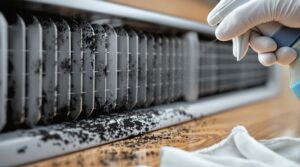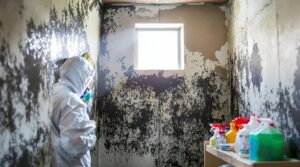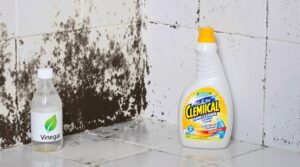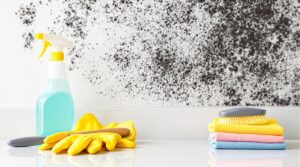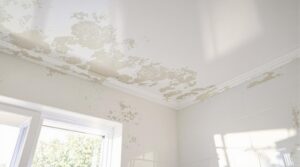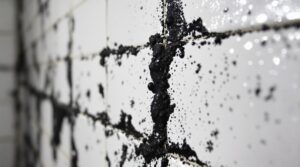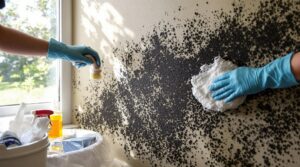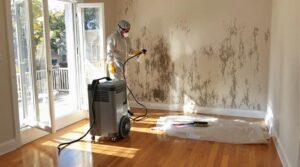Black mold on a bathroom ceiling can be effectively removed with a cleaning solution of bleach and water or a natural alternative like white vinegar. To prevent mold regrowth, guarantee good ventilation, and regularly inspect for and fix any leaks or moisture issues. Regular cleaning with antifungal solutions and thorough drying of surfaces after showers can also help prevent mold growth. Further guidance on removal methods, prevention techniques, and safety precautions can provide a more thorough solution to mold infestation. To ensure effective mold remediation, it’s essential to follow safety precautions, such as wearing gloves and a mask to avoid inhaling spores. Understanding how to remove black mold safely empowers homeowners to tackle infestations without risking their health. Additionally, for persistent problems, consulting a professional mold remediation service may provide specialized knowledge and tools for complete removal and prevention.
Key Takeaways
- Identify and fix the source of moisture causing the mold growth to prevent re-infestation.
- Wear protective gear like N-95 respirator, gloves, and goggles when cleaning moldy areas.
- Use a cleaning solution of 1 part bleach to 10 parts water, applying it to the moldy area for 15 minutes.
- Scrub the area gently with a soft-bristled brush, then rinse with clean water to remove solution and debris.
- Ensure good ventilation during and after cleaning, using fans or opening windows to speed up drying.
Warning Signs of Mold Infestation on Bathroom Ceiling
Black mold on the bathroom ceiling often manifests as black or dark green spots, indicating a moisture problem that requires immediate attention.
A musty odor in the bathroom can also signal the presence of mold, suggesting that it may be growing in unseen areas.
Visible stains or discoloration on the ceiling, even if not fuzzy or visibly moldy, can indicate underlying mold infestation.
In addition, health symptoms such as respiratory issues, allergies, or skin irritations experienced while in the bathroom can be linked to mold exposure.
Homeowners should be vigilant of these warning signs, as they can be indicative of a larger moisture problem.
Recognizing these signs is essential in addressing the issue promptly, thereby preventing further mold growth and potential health risks.
Regular inspections can aid in early detection and mitigation of mold infestation.
Mold can develop within 24-48 hours of water exposure, making quick identification and response crucial for prevention.
Preparing a Cleaning Solution to Remove Mold

Several effective cleaning solutions can be prepared to remove mold from bathroom ceilings. The key is to choose the right ingredients and proportions to guarantee a safe and effective removal process.
| Solution | Ingredients | Instructions |
|---|---|---|
| Small Area | 1 tbsp dish soap, 1/2 cup bleach, 1 cup warm water | Mix in a spray bottle |
| Large Area | 1 cup bleach, 1 gallon water | Mix in a plastic bucket |
| Tiled Ceiling | Bleach solution | Saturate area, let sit 15 minutes |
| Vinegar Solution | White vinegar | Spray directly, let sit 1 hour |
| General Precaution | Ensure good ventilation |
When preparing a cleaning solution to remove mold, it is essential to take into account the size of the affected area and the type of surface. White vinegar can also be used as a natural alternative to bleach. Always remember to wear protective gear and ensure good ventilation when handling cleaning solutions.
Proper spore dispersal prevention requires sealing doorways and vents with plastic sheeting before beginning any mold removal project.
Applying the Cleaning Solution to the Moldy Area
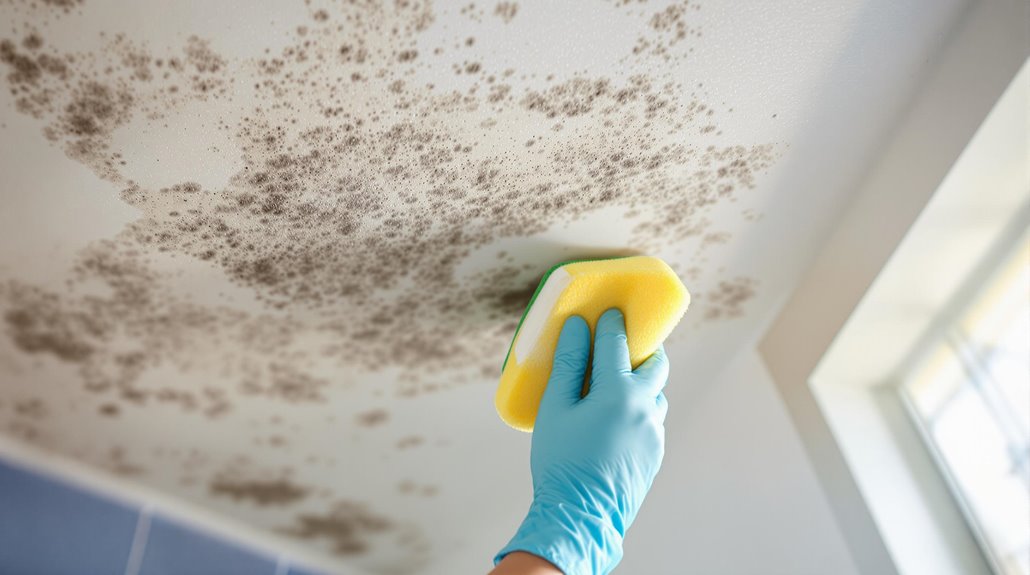
To effectively remove mold from a bathroom ceiling, applying the prepared cleaning solution is the next vital step.
Before application, verify the area is well-ventilated to disperse fumes and reduce inhalation risks.
Using a spray bottle or sponge, apply the solution to the moldy area until it is fully saturated. The solution should be left to sit on the surface for approximately 15 minutes to effectively kill mold spores.
After the waiting period, scrub the area gently with a soft-bristled brush to lift any remaining mold and stains, rinsing the brush frequently to avoid redepositing mold. The goal is to remove the mold without spreading it to other areas.
Once scrubbed, rinse the treated area with clean water to remove any remaining solution and debris. This process is vital in removing mold from the bathroom ceiling, guaranteeing a clean and safe environment.
For optimal results, maintain humidity levels below 50% using dehumidifiers to prevent future mold growth.
Removing Mold From a Tiled Bathroom Ceiling
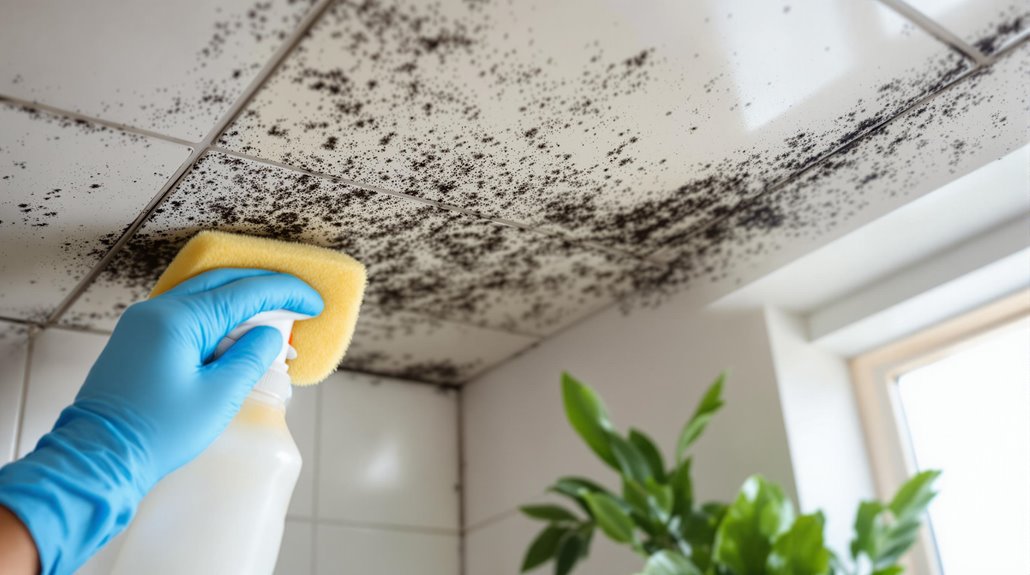
Removing mold from a tiled bathroom ceiling requires effective cleaning solutions, with options including a bleach-based solution of 1 cup of bleach per 1 gallon of water, or alternative products designed to target mold and mildew.
Safety considerations also play an essential role in the mold removal process, including proper ventilation and the use of protective gear such as gloves and goggles to minimize exposure risks.
Successful mold removal is often complemented by prevention techniques, such as thoroughly drying surfaces to prevent moisture retention and regular monitoring for early signs of mold growth.
Natural fungicides like tea tree oil mixed with water provide an effective alternative to harsh chemical treatments.
Mold Cleaning Solution Options
Effective mold removal from a tiled bathroom ceiling requires a suitable cleaning solution. A solution of 1 cup bleach mixed with 1 gallon of water is effective in removing black mold.
Alternatively, a mixture of 2 tablespoons of borax and 2 cups of warm water can be used. Vinegar is also a viable option due to its antifungal properties, which can help kill mold on nonporous surfaces. However, it may not remove stains.
The chosen cleaning solution should be applied to the moldy area, allowed to sit for a specified time, and then scrubbed. After cleaning, the ceiling should be rinsed with water and dried thoroughly with a soft cloth to aid in preventing mold regrowth. To ensure long-lasting results, it’s important to address any underlying issues that may have caused the mold growth in the first place. This includes learning how to fix ceiling leaks that may be contributing to moisture problems in your home. Regularly inspecting your ceiling for signs of water damage and taking proactive measures can help maintain a clean and healthy environment.
The right cleaning solution is essential for successful mold removal. White vinegar has been proven to eliminate 82% of mold species when used as a cleaning solution.
Mold Removal Safety Tips
When it comes to tackling mold on a tiled bathroom ceiling, a well-planned cleaning approach is only half the battle. Ensuring safety during mold removal is equally important.
To minimize health risks, always wear protective gear, including an N-95 respirator, gloves, and goggles. This prevents inhalation of mold spores and contact with the cleaning solution. Additionally, make sure the bathroom is well-ventilated by opening windows and using exhaust fans to reduce moisture levels and fume exposure.
Before applying the cleaning solution, moisten moldy areas to control airborne spores. A solution of 1 cup of bleach per gallon of water can effectively clean mold from tiled surfaces. For optimal results, maintain indoor humidity levels between 30-50% to prevent future mold growth.
Mold Prevention Techniques
Numerous factors contribute to mold growth on tiled bathroom ceilings, including humidity, poor ventilation, and inadequate cleaning.
Effective mold prevention techniques can inhibit mold spore germination and maintain a mold-free environment. Regular cleaning with antifungal solutions, such as vinegar or borax, is essential in preventing mold growth.
Additionally, controlling humidity levels is vital. Implementing an exhaust fan during and after showers can greatly reduce humidity levels, making it difficult for mold to grow.
Ensuring good ventilation and using an exhaust fan can also help to remove moisture and reduce the risk of mold growth.
Running bathroom fans for 15-20 minutes after showering helps eliminate excess moisture that promotes mold formation.
Preventing Future Mold Growth on Bathroom Ceiling

Preventing future mold growth on the bathroom ceiling requires attention to the bathroom's ventilation system.
Ensuring proper ventilation involves the regular use of exhaust fans during and after showers to reduce humidity levels, a key factor in inhibiting mold growth.
Implementing a regular cleaning schedule also plays an essential role in preventing mold buildup, as thorough cleaning and drying of moisture-prone areas can help maintain a dry environment.
Improving Bathroom Ventilation
Regularly ensuring adequate ventilation in the bathroom is essential for preventing future mold growth on the ceiling.
Effective ventilation can be achieved by installing a high-quality exhaust fan with an airflow capacity of at least 50 CFM. Operating the exhaust fan during and after showers reduces humidity levels and moisture accumulation, making it unlikely for mold to grow.
Additionally, opening windows or utilizing a circulating fan enhances airflow and dissipates moisture. In particularly humid climates, using moisture-absorbing desiccants or a dehumidifier can lower indoor humidity levels.
Adequate ventilation is vital to control humidity, which combined with regular cleaning, prevents mold growth on bathroom ceilings.
It is also recommended to keep the bathroom door open for at least 20 minutes after showering to improve air circulation.
Regular Cleaning Schedule
To inhibit the growth of mold on bathroom ceilings, establishing a routine cleaning schedule is essential. Implementing weekly cleanings using antifungal solutions helps remove potential mold spores before they grow.
| Cleaning Tasks | Frequency | Purpose |
|---|---|---|
| Squeegee or towel dry shower walls/ceiling | After each shower | Eliminate excess moisture |
| Run exhaust fan/open window | During/after showers | Improve ventilation |
| Inspect for/fix leaks | Regularly | Prevent damp environments |
| Use mold-resistant cleaning products | Ongoing | Provide barrier against mold growth |
| Repaint with mold-resistant paint | As needed | Additional mold growth protection |
This schedule contributes to effective mold prevention by combining regular cleaning, prompt moisture removal, enhanced ventilation, and mold-resistant measures.
Safety Precautions to Take When Cleaning Mold
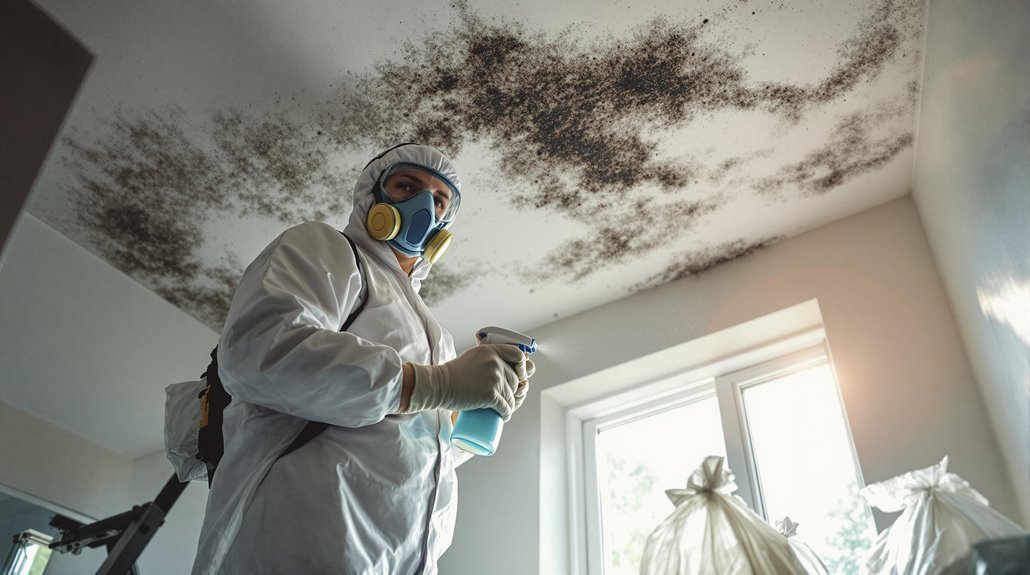
Mold remediation poses major health risks if not approached with caution. To mitigate these risks, safety precautions must be taken during the removal process. The most vital safety measure is wearing protective gear, including an N-95 respirator, gloves, and goggles. This equipment prevents the inhalation of mold spores and skin irritation.
Making certain the bathroom is well-ventilated is also fundamental. Opening windows and using exhaust fans can greatly reduce exposure to harmful fumes from cleaning solutions.
Before cleaning, the moldy area should be moistened with a spray bottle to minimize the release of airborne spores. Additionally, certain cleaning solutions should not be combined, such as bleach with vinegar or ammonia, as this can produce toxic gases.
Proper disposal of moldy materials, including wrapping them in plastic, is also essential to prevent cross-contamination. By taking these safety precautions, individuals can minimize their exposure to mold and guarantee a safer removal process.
When to Consider Professional Mold Removal Services

While some mold growth can be managed with DIY removal techniques, there are instances where professional intervention is necessary to guarantee a safe and effective cleanup process.
If the mold covers an area larger than 10 square feet, it's advisable to seek professional mold removal services due to potential health risks and the complexity of the cleanup process.
Additionally, persistent mold growth despite repeated cleaning attempts may indicate underlying moisture issues that professionals can identify and address effectively.
Professionals have access to specialized equipment, such as HEPA vacuums and advanced mold detection tools, which can assure thorough remediation and prevent future growth.
If health risks are a concern or if mold persists, seeking professional mold removal services is essential to assure safe and effective mold removal.
In such cases, professionals can assess the situation, identify underlying moisture issues, and provide a detailed solution.
The Benefits Of Consulting A Public Adjuster
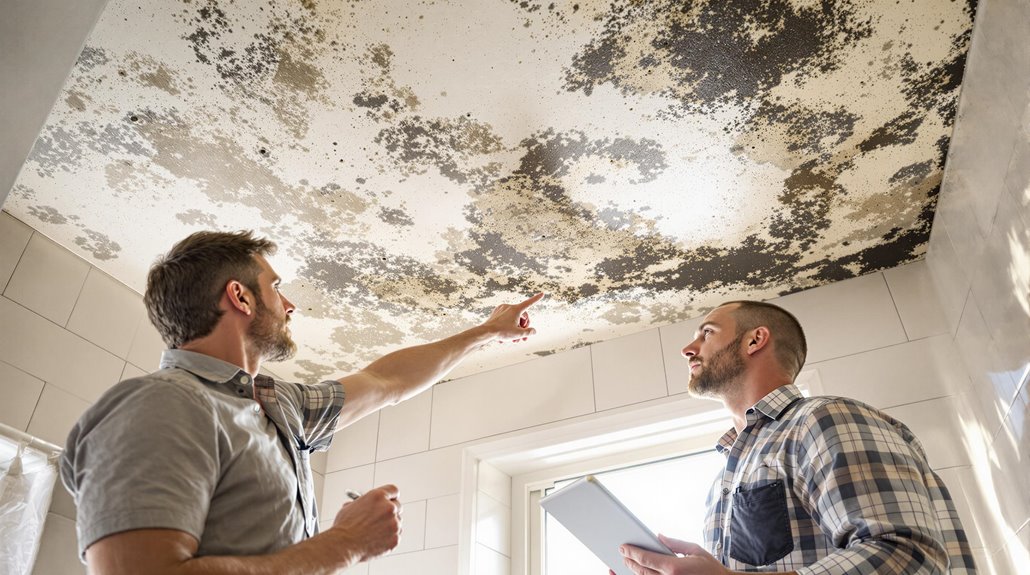
Consulting a public adjuster offers several key benefits, particularly in situations where black mold damage necessitates insurance claims.
A public adjuster's expertise in insurance claims and objective damage assessment guarantees a thorough and accurate evaluation of the damage, which is essential for a successful claim.
Expertise In Insurance Claims
In the event of mold-related damage to a bathroom ceiling, an essential step in the recovery process often involves steering through the complexities of insurance claims.
Consulting a public adjuster can greatly enhance the chances of receiving a fair insurance settlement by ensuring all damages, including those caused by mold, are accurately documented and valued.
Public adjusters possess expertise in navigating the complex insurance claim process, reducing stress and time involved for policyholders. They are licensed professionals who understand insurance policy terms and coverages, helping maximize mold damage claims.
On average, policyholders who enlist public adjusters receive 20-50% higher claim settlements.
Objective Damage Assessment
Damage assessment is a critical step in determining the extent of mold-related damage to a bathroom ceiling. Consulting a public adjuster can provide an objective assessment of mold damage, ensuring that all affected areas are accurately documented for insurance claims. This expertise can also help homeowners understand the full extent of mold-related damages and potential costs for remediation.
| Benefits of Public Adjuster | Description | Outcome |
|---|---|---|
| Objective Assessment | Accurate documentation of mold damage | Fair insurance claims |
| Industry Knowledge | Understanding of mold-related damages and costs | Informed decision-making |
| Negotiation Expertise | Effective communication with insurance companies | Higher settlement amounts |
Streamlined Claim Process
When dealing with black mold on a bathroom ceiling, the insurance claims process can be a challenging task for homeowners. Consulting a public adjuster can streamline the process by providing expert guidance on documentation and guaranteeing all necessary evidence is presented effectively for mold-related damage.
This professional guidance allows homeowners to focus on remediation efforts while the adjuster handles the complexities of the claims process, reducing stress during a challenging time. A public adjuster's expertise in negotiating with insurance companies also guarantees that all related damages are accounted for in the insurance claim, including the impact on property value.
Higher Claim Payouts & Settlements
While maneuvering through the complex process of filing an insurance claim for black mold damage on a bathroom ceiling, consulting a public adjuster can greatly impact the outcome.
Public adjusters are skilled negotiators who understand the complexities of insurance policies and can maximize coverage based on the specifics of the claim.
Some key benefits of consulting a public adjuster include:
- Higher settlements: Policyholders who work with public adjusters often receive settlements that are 20% to 50% higher than those who handle claims independently.
- Comprehensive documentation: Public adjusters provide thorough evidence to support claims, ensuring all damages, including hidden mold issues, are accurately accounted for.
- Expertise in claims processes: Public adjusters help policyholders avoid common pitfalls and maximize compensation for damages.
- Fee-based service: Public adjusters charge a fee, typically 5% to 15% of the total settlement, which is often a worthwhile investment given the potential increase in payout.
About The Public Claims Adjusters Network (PCAN)

Established to connect policyholders with expert professionals, the Public Claims Adjusters Network (PCAN) is an extensive national network of pre-vetted, verified, and state-licensed public adjusters specializing in residential and commercial property insurance claims.
With member adjusters covering over 30 claim types and operating in 40+ states, PCAN serves as a valuable resource for individuals and businesses managing complex insurance claims.
As a network of expert public adjusters, PCAN holds its members to the highest standards of ethics, morals, and professionalism.
Mandatory yearly audits of their licenses and any complaints guarantee that members remain accountable and trustworthy.
By connecting policyholders with top-tier public adjusters, PCAN facilitates informed decision-making and effective resolution of property damage claims.
Whether dealing with mold damage or other property-related losses, PCAN stands as a reliable resource for expert guidance and support throughout the insurance claim process.
Frequently Asked Questions
How Do I Get Rid of Black Mold on My Bathroom Ceiling Permanently?
Effective mold removal techniques involve proper ventilation, thorough cleaning with bleach solutions, and scrubbing with soft-bristled brushes. Prevention methods include using mold-resistant paints, dehumidifiers, and addressing underlying moisture issues to mitigate health effects.
Is Mold on a Bathroom Ceiling Harmful?
Like a silent predator, mold on a bathroom ceiling lurks, posing significant health risks, including mold allergies and respiratory issues, while also threatening home damage through its insidious, destructive power, compromising both human well-being and structural integrity.
Is Bleach or Vinegar Better to Kill Mold?
Bleach effectiveness is diminished on porous surfaces, whereas vinegar's antifungal properties excel on nonporous surfaces, prioritizing vinegar safety and efficacy in mold removal. Cleaning solutions containing vinegar are suitable alternatives for thorough mold eradication.
What Causes Black Mould on a Bathroom Ceiling?
A canvas of condensation, the bathroom ceiling invites mold to flourish. Poor ventilation, excessive humidity, and warmth foster growth. Key factors include inadequate bathroom ventilation solutions, ineffective humidity control methods, and neglecting mold prevention tips.
